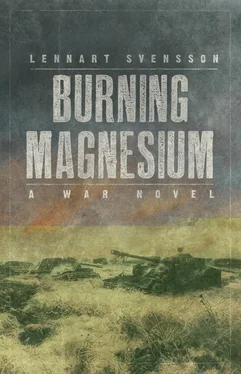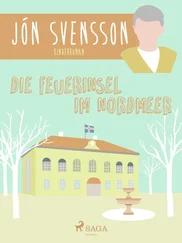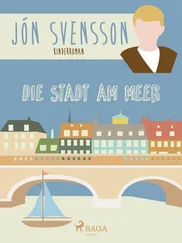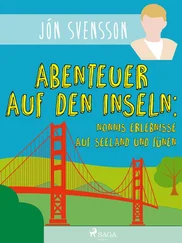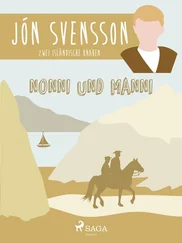+++
Arno’s Squad went in single file over the monotonous plain. The sun had gone down. It was relatively mild, minus five centigrade. Arno led the way, clutching his MP and looking forward. He only saw deserted plains and a red sky. Smoke was on the wind. The snow lay in a thin blanket, last year’s grass sticking up here and there. Here and there you even saw bare ground, spots in late-autumn brown.
+++
The SPW’s of the platoon halted in the village. The men got out and stretched. They walked aimlessly around among the deserted houses, moving among bizarre ruins casting strange shadows. Arno for his part sat down in the backyard and looked up at a chilly blue autumn sky.
+++
The night had been spent on spruce branches in a foxhole. Arno focused. He woke up and displayed the ideal image of a combat ready front leader: scarred but calm face, his hand on the MP, pulse 70 and senses on edge. The day continued with rustlings in the trees and shell trajectories arching in the grey-green sky, a steel grey lake, the din of battle echoing between buildings, the streets distorting the sound waves and making everything surreal. It was about sauntering among the ruins while FW 189s returned from a mission, a squadron heading west at low altitude.
Then there was defence on a forest edge with the approach of the enemy, the Germans deployed in ambush 50 metres into the forest with a free field of fire, seeing the mustard brown soldiers nearing their position, withholding fire until they were close, knowing that you couldn’t miss now…
+++
Seeing violet, gold-lined clouds, drinking Ersatz coffee with its acorn bitterness, loading and travelling in their Hanomag SdKfz SPW’s over a plain, seeing smoke on the horizon, petrol fires, looming clouds of smoke.
+++
These were some telling fragments from this stage; that was how the Germans retreated through Ukraine during the late autumn and winter of 1943. The retreat was largely orderly. Some smaller Kessels were created, like Tjerkassy. Trapped men died in them, but strategically they were inconsequential. The Eastern Front wasn’t broken, the German Army still operated coherently.
In the New Year of 1944 Battalion Wolf grouped in northwestern Ukraine. There it eventually became encircled in what became known as Hube’s Pocket.
Sergeant Arno Greif sat by a table in his room in the platoon quarters. It was late in the evening of March 28, 1944. He was smoking a cigarette, now and again knocking the ash off into a porcelain dish. The room had walls of wood paneling and a floor covered by green-grey linoleum. In one corner stood a bed. From the ceiling hung a naked light bulb.
Arno sat in his shirtsleeves, having just cleaned his new 7.92 mm carbine. Driven by gas pressure, the StG 44 was a new weapon only beginning to be distributed among field units. It was a sort of assault rifle or automatic carbine. A pressed sheet metal, wooden butt of wood and a curved magazine holding 30 rounds. The gun combined the best of the rifle and the MP, having a shorter firing range than the rifle, much wider than the MP but otherwise with the MP’s rate of fire and capacity.
The effective range of this Sturmgewehr was about 300 metres, a good figure for the usual distance in infantry battles. All soldiers in the current platoon had StG’s, the other platoons of the company still had the Kar 98 rifle. You would think that the Company’s foremost Platoon, 1 stPlatoon, would be equipped with the latest but Thomas Shasta, 1 stPlatoon Leader, thought along the lines, “You know what you have but not what you get” so therefore Arno’s Platoon, 3 rd, was equipped with the new weapon instead.
Arno willingly gave up his MP for this new weapon. The StG had it all: firepower, satisfactory range of fire and it looked the business. The old saying, “What looks good usually is good,” springs into mind.
Arno took a drag on his cigarette, inhaled deeply and glanced at a clock on the wall. The small hand at eleven and the big at twelve.
2300 hours.
Four hours til they march.
Four hours until marching out for the general attack, the Breakout. They were, as already noted, encircled. Now they would break out. At the end of March 1944 Battalion Wolf and Kampfgruppe G as part of Hube’s 1 stPanzer Armee had been encircled between the Bug and Dniester to the north and the south. The focal point of the Kessel was the city of Kamenetsk-Podolsky. Therefore, the whole was called the Kamenets-Podolsky Pocket. You could also call it Hube’s Pocket after the General who planned the breakout, 1 stPanzer Armee Commander Hans-Valentin Hube.
They were encircled; they were in a Kessel , a motti or a pocket. The following ten chapters are about Hube’s Pocket and how Arno and 1 stPanzer Armee fought to break out of it. This was a struggle of epic proportions. It was, you might say, a “March of the Ten Thousand”, mechanised variety, an Eastern Front Anabasis , a breakout of a total unit strength of 200,000 men. The Anabasis of Xenofon in 399 BC for its part was the heroic march home by an army of mercenaries, stranded in the middle of the Persian Empire, the force eventually heading home to Greece. This chronicler recorded the army as 10,000 strong, the adventure thus being known as “The March of the Ten Thousand”.
In the Kamenets-Podolsky operation 1 stPanzer Armee was encircled, but it would break out. The plan was to move as a mobile 360-degree defensive position, forcing through the landscape like a veritable armoured amoeba. This was the accepted tactic for encirclement breakout. We’ve seen it before in this story, as in the retreat from Kharkov Arno participated in. But the breakout from Hube’s Pocket was, as far as breakouts went, a much bigger operation. It’s probably the greatest successful motti-breakout in the history of warfare. Hube made it out, with most of his army intact and would knock out a number of Russian tanks in the process.
+++
After the battle of Kursk in July 1943, the Russians, as we have seen, went forth to liberate their country – even though just how “liberated” it would be with the Bolsheviks still at the helm is a moot point. The main effort was in Ukraine. Kiev was taken in November 1943. The German front in northwestern Ukraine was held by Hans-Valentin Hube’s 1 stPanzer Armee. It had 18 Panzer and Panzer Grenadier divisions, divided into three Armoured Corps. There was also a regular Army Corps alongside them.
The Army numbered about 200,000 men. And it was encircled in March, 1944, by the Russian Commander of the sector, Georgi Zhukov, the victor of Moscow and Stalingrad. Hube was eventually caught north of the Dniester and south of the Bug.
Hube asked Oberkommando des Heeres if he could break out. After some days he got the OK. He then reduced his four corps into three Corps Groups. The two Panzer Corps thus created would take the lead in breaking out towards the northwest. The Army Corps would bring up the rear, making a fighting retreat.
As for the spearheads they would advance in parallel, forming a southern and a northern column; that is, both were going towards the northwest but in the following there will be references to the “northern” and “southern” spearhead, descriptions that merely designate their relative positions to each other. In the lead the spearheads had battalions from Kampfgruppe Bäke, equipped with Panther and Tiger tanks.
Hube’s Army would breakout towards Tarnopol in the northwest. It was a distance of 250 km, over the rivers Zbruch and Seret and through muddy terrain. In the Tarnopol region, units from Hausser’s 2 ndSS Panzer Corps would sally forth to meet the breakout force.
Читать дальше
